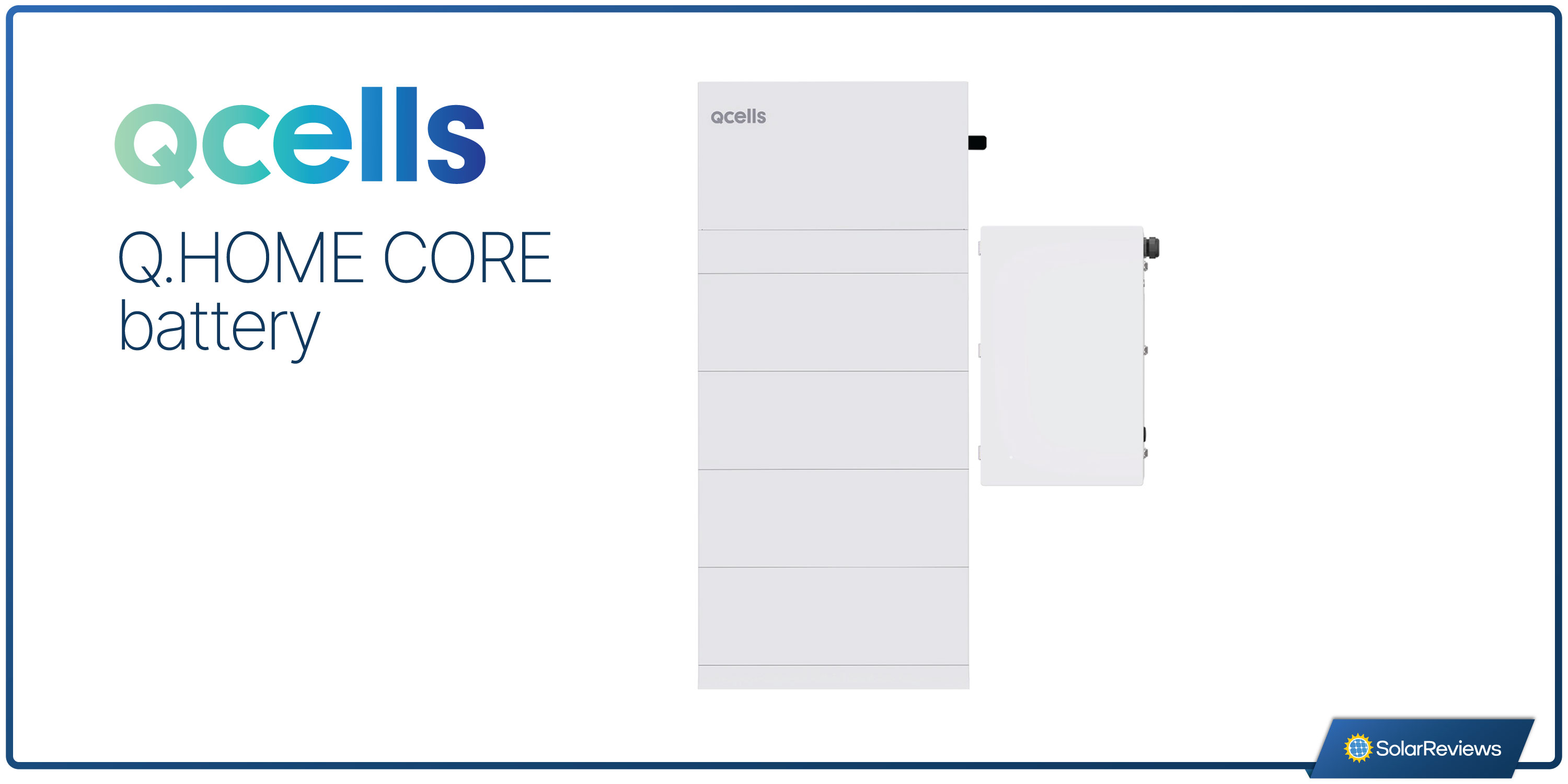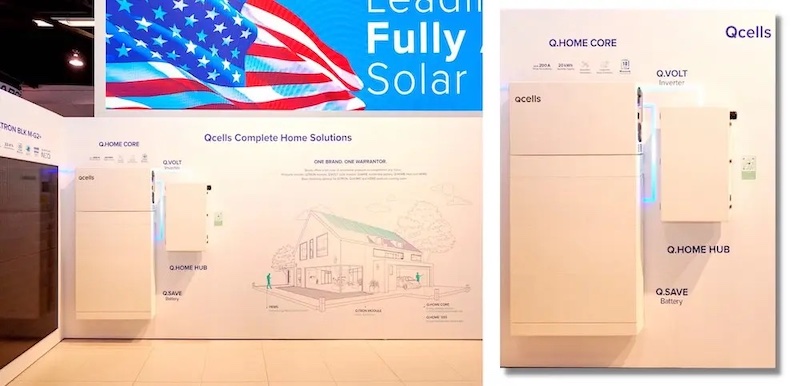Updated 1 month ago
Q.HOME CORE expert review: all about Qcells' energy storage system
Written by Catherine Lane Catherine LaneCatherine has been researching and reporting on the solar industry for five years and is the Written Content Manager at SolarReviews. She leads a dyna...Learn more , Edited by Gianna Cappuccio Gianna CappuccioGianna Cappuccio is an editor at SolarReviews. After obtaining a Bachelor's in English from Montclair State University in 2016, Gianna decided to purs...Learn more

Why you can trust SolarReviews
SolarReviews is the leading American website for solar panel reviews and solar panel installation companies. Our industry experts have a combined three decades of solar experience and maintain editorial independence for their reviews. No company can pay to alter the reviews or review scores shown on our site. Learn more about SolarReviews and how we make money.
Qcells is one of the most trusted names in solar, so it's no surprise its panels are installed on more homes than any other brand in the U.S. The company isn’t just all about home solar panels - it's been in the energy storage business since 2016.
The brand’s current storage offering, the Q.HOME CORE, is a complete home energy storage solution that includes an inverter, a modular battery design, and an energy management hub.
The Q.HOME CORE landed in eighth place on our best solar batteries list of 2025 and can make a great addition to homeowners looking for backup power. Let’s look closer at Qcells’ battery and how it stacks up to the competition.
Key takeaways
Qcells’ Q.HOME CORE energy system includes the Q.VOLT inverter, Q.SAVE battery, and Q.HOME HUB for energy management.
The battery can hold between 9 and 18 kWh of usable energy storage.
You can expect to pay between $10,500 and $18,300 for a Q.HOME CORE system, depending on the size and the installer you choose.
Qcells offers a battery performance warranty of 70% capacity after 6,000 cycles or 12 years, whichever comes first.
The Q.HOME CORE system could make Qcells a popular choice not just for solar panels but for energy storage as well.
What’s installed with the Qcells Q.HOME CORE battery?

The Q.HOME CORE system consists of three components:
The Q.VOLT inverter
The Q.SAVE battery
The Q.HOME HUB
Each piece has a sleek, thin, all-white design, so it’s not an eyesore when installed. It’s suitable for both indoor and outdoor installation, making it easy to find a place to put it.
Q.Volt inverter
Qcells’ battery comes with an integrated solar battery inverter, the Q.Volt. The inverter converts the DC energy stored in the battery into AC electricity that home appliances can use.
The Q.Volt inverter comes in two sizes: one that supports solar systems up to 7.6 kilowatts (kW) in size and one that is designed for larger systems up to 15.2 kW. The inverter is located at the top of the battery unit and connects to the battery modules below.
Q.SAVE battery units
The Q.HOME CORE system is scalable, meaning you can install more or fewer battery units depending on your needs. Each battery pack, a Q.SAVE unit, has a total storage capacity of 5 kilowatt-hours (kWh)— enough power to run a standard refrigerator for about 10 hours.
You can purchase a Q.HOME CORE storage solution with two, three, or four Q.SAVE units to get the amount of storage that suits your lifestyle best!
Q.HOME HUB
The Q.HOME HUB is the energy management system for the Q.HOME CORE. It is where the batteries are wired together and connected to the electrical service panel. You can think of it as the system's communication center, where the electric grid, solar system, and battery all connect.
Performance features of the Qcells Q.HOME CORE energy storage system
The Qcells Q.HOME CORE storage system has some solid operating specs.
Model | Q.SAVE D10.0SX | Q.SAVE D15.0SX | Q.SAVE D20.0SX |
|---|---|---|---|
Number of battery modules | 2 | 3 | 4 |
Usable energy | 9 kWh | 13.5 kWh | 18 kWh |
Round trip efficiency | 95% | 95% | 95% |
Maximum power output | 5.5 kW | 8.3 kW | 11.1 kW |
Usable capacity
The usable capacity measures how much energy you can store and use from your battery system. Capacity is often used to describe the size of the battery.
The Q.SAVE comes in three sizes: 9 kWh, 13.5 kWh, and 18 kWh. Most homeowners will be fine with the 9 or 13.5 kWh options. But bigger homes may need more storage, which is where the 18 kWh comes in handy.
You may also want more capacity if you run your appliances off-grid for an extended period. For example, if you live somewhere that experiences regular prolonged blackouts, a bigger battery can run your key electrical loads for longer.
Maximum power output
The maximum power output is the highest amount of power a battery can release to run appliances.
Usually, we would tell you to check out the continuous power output, as that tells out the output a battery can sustain over a long time. But Qcells only lists the maximum power, which a battery is typically only capable of releasing in short bursts.
Most batteries usually have a continuous power output of 5 kW, so the Q.HOME CORE’s maximum output of 5.5. kW is a little low. You can probably find more powerful batteries if you need to run more power-hungry appliances.
Round-trip efficiency
A battery’s round-trip efficiency gives you an idea of how a battery stores and releases energy. 95% efficiency is great and means there are minimal energy losses in the storage process.
How much does the Q.HOME CORE system cost?
Equipment cost | Installation labor costs | Total installed cost |
|---|---|---|
$7,500 - $13,300 | $3,000 | $10,500 - $18,300 |
The Qcells Q.HOME CORE battery costssomewhere between $10,500 and $18,300, including installation. The price will vary depending on the battery size you install and the installer you choose. Most solar battery installations fall in this price range.
The Q.HOME CORE is slightly more expensive than some other battery options. For example, the Tesla Powerewall costs about $15,500 when installed by Tesla.
That’s a lot of money, but the Q.HOME CORE qualifies for the 30% federal solar tax credit, which helps reduce the cost of installing a battery system. Other solar battery rebates and incentive programs may be available to cut the price further!
How long will the Q.HOME CORE system last?
The entire Q.HOME CORE system should last for a little over a decade. All components of the system come with 12-year warranties.
When it comes to performance, the Q.SAVE batteries have a 6,000-cycle, 12-year warranty that guarantees 70% capacity retention. This is a solid warranty, and you can expect to reach the full 12 years before hitting the cycle limit.
There are some warranties that outshine Qcells, like Enphase or Panasonic, but it still exceed industry standards.
Is the Q.HOME CORE system right for me?
Overall, the Q.HOME CORE is a pretty average energy storage system. It doesn’t wow us when it comes to performance specs, and the warranty isn’t as good as what some competitors offer, but because it’s coming from Qcells, it’s likely a reliable system.
Qcells is one of the most popular and trusted brands in the solar industry. In fact, they took the top spot in our best solar panels list two years in a row! The company makes high-quality products and provides great customer service. Plus, the system looks great. The design is thin and discrete so that it won’t stand out in your garage or on the side of your home, and we love that it’s modular for better customization for your needs.
We wouldn’t go out of our way to seek out a Q.HOME CORE, but if presented with a quote from a trusted solar company for a reasonable price, we’d be pretty excited! The system will get the job done for what most homeowners need, and if you’re getting Qcells panels, it’s always a plus to have equipment from the same brand.
The best way to find the right energy storage system for you is by talking to solar installers in your area. Local solar companies can give you insight into what batteries will meet your needs and what systems your neighbors have liked the best so you can start storing your solar energy!
Other solar battery options
Curious about other solar battery brands? Check out these expert battery reviews!
-Canadian Solar EP Cube battery
- SunPower SunVault battery review
- Electriq PowerPod 2: Complete review
Catherine has been researching and reporting on the solar industry for five years and is the Written Content Manager at SolarReviews. She leads a dynamic team in producing informative and engaging content on residential solar to help homeowners make informed decisions about investing in solar panels. Catherine’s expertise has garnered attention from leading industry publications, with her work being featured in Solar Today Magazine and Solar ...
Learn more about Catherine Lane